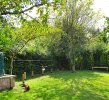DGE-Railroad
The Orchard Line
Thanks to a bit of sun and a helpful 3yo, The Orchard Line as it is now known is beginning to take shape.
The posts are pretty much in. It's amazing to see how much undulation there is in what ostensibly feels a 'flat' piece of land!
I'm just waiting on the arrival of a pipe location tool, to figure out where exactly the subterranean heating oil pipe goes. I really don't want to put a spike through it!
Next up, a pile of 300mm Hot-Dip-Galvanised cable trays so that work on the trackbed can start. I'm trying to figure out the best way to mount these to the posts - a stringer plate I guess, on top of the post and running in the direction of the track to add some rigidity to the span, but should I have some lateral support across the width of the cable tray on the of the post too? Any suggestions are most welcome.

The posts are pretty much in. It's amazing to see how much undulation there is in what ostensibly feels a 'flat' piece of land!
I'm just waiting on the arrival of a pipe location tool, to figure out where exactly the subterranean heating oil pipe goes. I really don't want to put a spike through it!
Next up, a pile of 300mm Hot-Dip-Galvanised cable trays so that work on the trackbed can start. I'm trying to figure out the best way to mount these to the posts - a stringer plate I guess, on top of the post and running in the direction of the track to add some rigidity to the span, but should I have some lateral support across the width of the cable tray on the of the post too? Any suggestions are most welcome.





